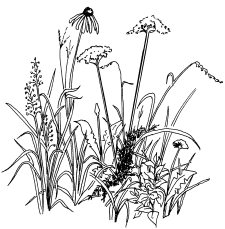
Indicator Species
Bells Vireo: Vireo bellii
IUCN (International Union for the Conservation of Nature) status: Near threatened.
Natural history:
Neotropical Migrant bird. (migratory between north and central/south America) This species summers in the great plains and desert southwest. Winters in Mexico and Central America. Insectivorous. Primary population threat is habitat loss due to intensive agriculture and human development of old fields and barren areas. Preyed upon by mammals such as raccoons, opossum, or birds of prey such as hawks or owls. All birds are susceptible to the accumulation of neonic insecticides within the food chain.
Habitat:
Shrubby, early-mid successional growth. Nests are built in thickets 2-3 feet off the ground. Favored habitat are shrubby thickets and old abandoned fields. Is not commonly found in pure grasslands or thick forests, but often in the transition period of succession between the two.
Range:
http://maps.iucnredlist.org/map.html?id=22705156
Links:
http://www.allaboutbirds.org/guide/Bells_Vireo/id
https://www.audubon.org/field-guide/bird/bells-vireo
http://climate.audubon.org/birds/belvir/bells-vireo
https://en.wikipedia.org/wiki/Bell's_vireo
Guiding questions for predicting the future of this species at Tucker Prairie:
-
Does this species account lend evidence to support the ability to adapt to changing vegetation, soil moisture, and climate?
-
Are the habitat requirements for this species broad or specific?
-
What is your prediction for the success of this species at Tucker Prairie if climate change results in a gradual conversion of Tucker Prairie from native prairie to shrubs and eventually woodland?
-
What does this species eat? What other species eats the Bell’s Vireo?
-
Thinking long term, apply your answers to the previous three questions to 100 years or more if Tucker Prairie eventually becomes a forest woodland.
-
Why should we care about changes in the population of a birds like the Bell’s Vireo or Henslow’s sparrow? Socially is this important or not? Why?



